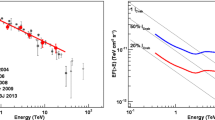Abstract
The HEGRA experiment investigates the relativistic (non thermal) universe by measuring air showers initiated in the atmosphere by photons and charged particles from the cosmos, using the imaging atmospheric Cherenkov light technique (> 500 GeV) and the showerfront sampling technique (> 20 TeV). New results concerning the search and study of gamma ray sources above 500 GeV, the measurement of the energy spectrum and chemical composition of cosmic rays above 1 PeV and the search of TeV counterparts of Gamma Ray Bursts are briefly described.
Similar content being viewed by others
References
For a list of publications of the HEGRA collaboration see the web address www.gae.ucm.es. See also the HEGRA contributions to the Proceedings of the 25th International Cosmic Ray Conference 1997, Durban (South Africa) and proceedings of the 16th European Cosmic Ray Symposium 1998, Alcalá (Spain).
Author information
Authors and Affiliations
Rights and permissions
About this article
Cite this article
Fonseca, V. Status and Results from the HEGRA Air Shower Experiment. Astrophysics and Space Science 263, 377–380 (1998). https://doi.org/10.1023/A:1002101216613
Issue Date:
DOI: https://doi.org/10.1023/A:1002101216613




